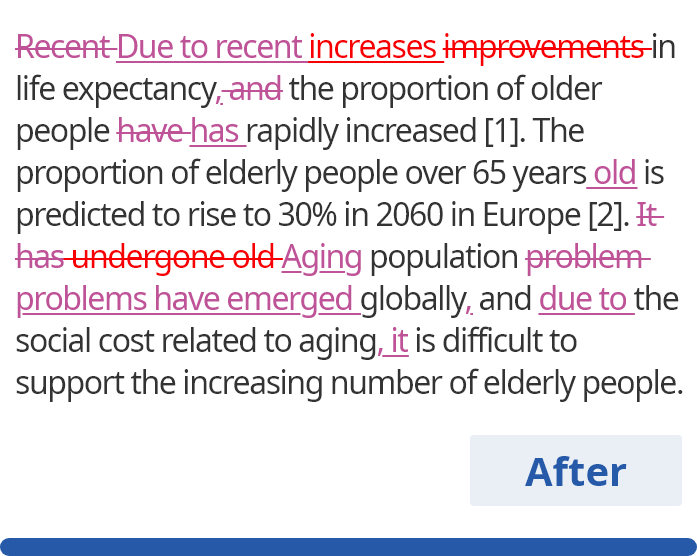連接詞的使用規則
連接詞是用來連接單字、片語或子句的詞。最常用的連接詞包括“and”、“but”和“or”。連接詞包括三種類型:並列連接詞, 從屬連接詞, 相關連接詞。
連接詞的種類
| 連接詞的種類 | 連接詞的作用 | 連接詞的例子 |
|---|---|---|
|
並列連接詞 |
連接在語法上對等的內容 |
for, and, nor, but, or, yet, so |
|
從屬連接詞 |
引出從屬子句 |
because, if, although, since, until, and while |
|
相關連接詞 |
成對出現,並連接在語法上對等的內容 |
either/or, neither/nor, not only/ but also |
目錄
- 1.並列連接詞
- 2.從屬連接詞
- 3.相關連接詞
- 4.以連接詞開頭的句子
- 5.連接詞和逗號的聯用規則
並列連接詞
並列連接詞連接在語法上對等的單字、片語或子句。常用的並列連接詞包括:for, and, nor, but, or, yet, so。可以採用“F.A.N.B.O.Y.S.”這個便於記憶的詞頭拼接詞記住上述七個並列連接詞。
- 例句
- This study investigates the effects of Drug A and the placebo on the patients.
- 例句
- You can choose to take the test or write an essay to pass the class.
當使用並列連接詞連接兩個獨立子句時,在並列連接詞前面要加逗號。
- 例句
- She was unhappy with the test results, yet she refused to take the test again.
- 例句
- I have only been here for one week, so I know practically nothing.
- 錯誤
- You should invite Mary, and Jane to the party.
- 正確
- You should invite Mary and Jane to the party.
從屬連接詞
從屬連接詞可以把子句和主句連接起來。從屬連接詞用來表示因果關係、對比、時間或地點的過渡或條件關係。最常用的從屬連接詞包括:after, although, before, even though, if, in case, till, whenever, unless, while。
表示因果關係
表示因果關係的從屬連接詞包括:because, since, as, due to, as if。
- 例句
- I could not go to class because I did not feel good.
- 例句
- Due to his poor attendance, the professor had to fail him.
表示對比關係
表示對比關係的從屬連接詞包括:although, though, whether, while, even though。
- 例句
- While she plans to go to Paris for spring break, he plans to go to Tokyo.
- 例句
- Although he is much younger than me, he is much smarter than most of my classmates.
表示條件關係
表示條件關係的從屬連接詞包括:if, unless。
- 例句
- Unless you leave now, you will be late.
- 例句
- If he decides to take the offer, he will have to move out soon.
表示時間或地點的過渡關係
表示時間或地點的過渡關係的從屬連接詞包括:where, everywhere, after, until, as soon as, before。
- 例句
- Don't forget to clean your room as soon as you get home.
- 例句
- This is the place where I grew up.
相關連接詞
相關連接詞是成對使用的單字,用來連接一個句子中的兩個部分或使其彼此關聯。最常用的相關連接詞包括:either/or, neither/nor, not only/but also。
在使用相關連接詞時,它們之間通常無需用逗號隔開。
- 錯誤
- I will either have a sandwich, or salad for lunch.
- 正確
- I will either have a sandwich or salad for lunch.
- 錯誤
- Neither the boy, nor his brother want to help their mother.
- 正確
- Neither the boy nor his brother want to help their mother.
但是,當相關連接詞(例如“not only/but also”)用於分隔兩個獨立子句時,連接詞前面應加逗號。
- 錯誤
- Not only did she start playing the piano at a very young age but her mother also taught her to compose music.
- 正確
- Not only did she start playing the piano at a very young age, but her mother also taught her to compose music.
以連接詞開頭的句子
很多人說以連接詞開頭的句子在語法上不正確。然而事實並非如此。雖然不建議在太多的句子開頭使用連接詞(尤其在學術寫作中),但適度使用是完全沒有問題的,而且有些時候必須用連接詞開頭寫句子。
- 例句
- She wanted to go home. But he did not want to.
- 例句
- Although I do not like the restaurant, I will go if you want me to.
- 例句
- Either this dress or that pair of pants is fine.
連接詞和逗號的聯用規則
無論何種類型的連接詞,連接詞與逗號聯用的規則都非常簡單,即使用連接詞連接兩個獨立子句時,連接詞前面應該使用逗號。
- 例句
- The professor explained the assignment in detail, but the students did not seem to understand it.
- 例句
- The weather is nice, but I don't think we should go on the picnic.
但是,當用連接詞連接一個獨立分句和一個從屬分句時,連接詞前面不應該使用逗號。
- 錯誤
- The professor explained the assignment in detail, and gave out the workbook.
- 正確
- The professor explained the assignment in detail and gave out the workbook.
- 錯誤
- The weather is nice, but a little bit chilly.
- 正確
- The weather is nice but a little bit chilly.
需要注意的是,使用逗號連接兩個獨立子句也有例外,即如用連詞連接的兩個獨立子句都很短,則可以省略連詞前面的逗號。
- 錯誤
- I cooked, and he cleaned.
- 正確
- I cooked and he cleaned.
在主句前的介紹性子句、片語或單字後面要用逗號。用於這些子句或片語的連接詞通常包括:after, although, as, if since, when, while。
- 例句
- While I do my homework, you go do the dishes.
- 例句
- If you do not want to go to the party, you can stay home.
正確使用連接詞更能清楚地表達句子之間的邏輯關係,讓文章更具連貫性與可讀性。所以撰寫任何文章時,都必須精準使用連結詞,對連結詞寫作沒有信心的話,也可以使用標點符號檢查器找出連接詞錯誤或改善使用方法,確保寫作既正確又專業。











